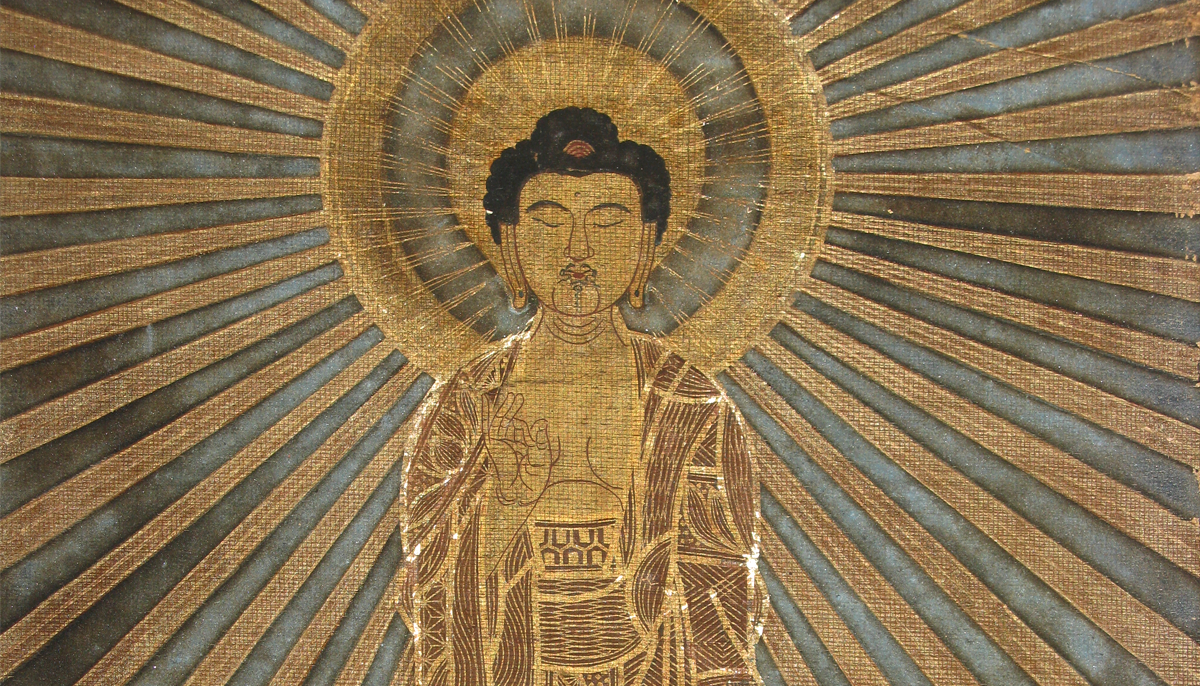In thirteenth-century Japan, a Tendai monk named Shinran admitted that, even after 20 years, he was unable to adhere to the precepts due to his passions and desires. He left the monastery on Mt. Hiei to join a new school of Mahayana to become a disciple of another Tendai monk named Honen. Over time, this new sect gained popularity among the laity, which concerned some leaders of the older schools of Buddhism. They soon devised a scheme to disband the group. Shinran was defrocked and exiled to northern Japan to live among peasants. During these years, he became the first monk to openly marry, declaring he was neither a monk nor a lay person. The Buddha had a path for those who could not abandon conventional life, he realized.
Upon the altar, Amida Buddha provides a visual connection to the unseen spiritual realm that pervades the mundane.
Shinran’s teachings are now known as Shin Buddhism. The unique perspective that the tradition offers the lay person is a path toward awakening that doesn’t require the strict practices of monastics. According to Shinran, the tradition should be deemed the “easy path,” because you’re not required to perform arduous or arcane practices to achieve higher and higher mental states. Instead, Shin Buddhism recommends reliance on the compassion of Amida Buddha.
The Japanese word Amida comes from the Sanskrit amita, meaning “limitless, infinite.” Amita itself is a shortened portmanteau of two other Sanskrit words: amidtabha (“immeasurable light”) and amitayus (“limitless life”).
The historic Shakyamuni Buddha conveyed the evolution of Amida Buddha in mythical terms in the Larger Sukhavativyuha Sutra. The sutra tells us that the bodhisattva Dharmakara worked for many eons to fulfill 48 vows he’d made. Fulfilling these vows, he became Amida Buddha, who resides in his Western Pure Land, a setting of eternal light and life.
How might we interpret this legend from a contemporary, science-based viewpoint? Keeping in mind the Sanskrit root words of Amida, light and life are two phenomena that comprise all the known elements of earth. Scientists report that the earth (and everything it contains) have coalesced over billions of years from the energy, or light, of a star — our sun. The elements of light and life have often been equated with the human characteristics of wisdom (light, or amidtabha) and compassion (life, or amitayus). So, the effect the energetic elements of light and life have on the human realm illustrates the impact Amida Buddha’s wisdom and compassion have on our world. Furthermore, Amida Buddha is described in Shakyamuni’s sutra as having a body that is “pure and bright like the sun.”
Amida Buddha, as a statue, a picture, or written name, is placed in the central position of honor on a Shin Buddhist altar. From an American perspective, it’s understandable to assume Amida Buddha represents a deity. In America, the default model of religion is Christianity. The figure of Christ or a cross represents the human connection with God, a focal point for worship. So, to a Westerner, the gassho posture (palms together near the chest) and recitations of Shin Buddhism directed toward a picture or statue of Amida Buddha could create another false assumption that Amida is a type of god.
Upon the altar, Amida Buddha merely provides a visual connection to the unseen spiritual realm that pervades the mundane. The recitation of “Namo Amida Butsu,” known as the nembutsu, has the same intention. As a temple minister, I witness how the lives of Shin followers are enhanced by this association with the sacred.
The picture or statue of a human form of Buddha and the six Chinese characters that comprise the nembutsu provide a physical representation of dharmakaya, the level of truth that is inconceivable. The picture or statue of Amida Buddha has several symbolic messages. The standing Amida leans forward to symbolize the wisdom and compassion that move to affirm us. The robe is open at the heart for generosity. The hand positions (mudras) assure us to come as we are. All beings are accepted, and no one rejected. This welcoming affirmation provided by Amida Buddha is fundamental in the awakening to our unique potential as humans on an earth that is impermanent in a universe that is interdependent.
The practice of voicing “Namo Amida Butsu,” which literally means, “Bow for the same of Amitabha Buddha,” is not a petition for a better life, nor is it expressing devotion to a deity. It’s a deeply spiritual experience which is difficult to describe. The simple answer would be to say it’s an expression of gratitude. Grateful, we awaken to everyone’s inclusion in the process of dependent origination. The nembutsu reminds us of the singularly unique gift of human life; this gift of life is due to the efforts of others, not due to our personal efforts.
It is this unique perspective of Shin that guides us to recognize that our lives and our awakening are received from the efforts of others. Interdependence reveals we are truly supported by others and this realization results in a response of gratitude. Our gratitude offers a completely different reality, different from the context of prayer or petition for a personal desire. Gratitude becomes the open gate to a vast field of benefits.
